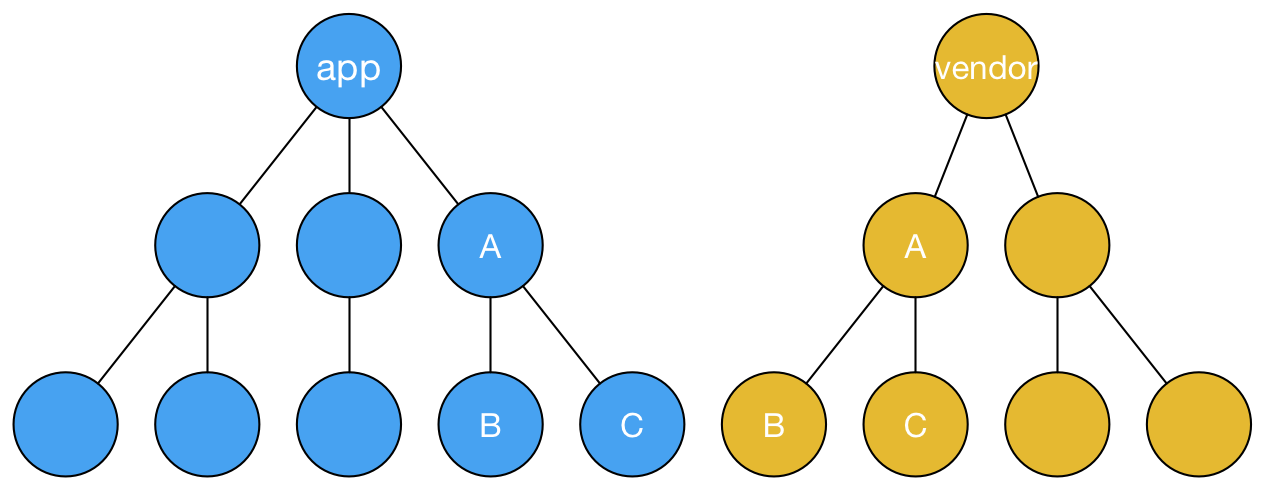拆分生成文件
目前为止我们只有一个js文件,如果依赖文件更新,则需要整个应用更新。
设置vendor输出
为react单独添加一个entry属性vendor
...const common = {entry: {app: PATHS.app,vendor: ['react']// app: PATHS.app},output: {path: PATHS.build,filename: '[name].js'},plugins: [new HtmlWebpackPlugin({title: 'Webpack demo'})]};...
[webpack-validator] Config is valid.Hash: 6b55239dc87e2ae8efd6Version: webpack 1.13.0Time: 4168msAsset Size Chunks Chunk Namesapp.js 25.4 kB 0 [emitted] appvendor.js 21.6 kB 1 [emitted] vendorapp.js.map 307 kB 0 [emitted] appvendor.js.map 277 kB 1 [emitted] vendorindex.html 190 bytes [emitted][0] ./app/index.js 123 bytes {0} [built][0] multi vendor 28 bytes {1} [built][36] ./app/component.js 136 bytes {0} [built]+ 35 hidden modulesChild html-webpack-plugin for "index.html":+ 3 hidden modules
app.js并没有小,因为app和vendor之间相同部分并没有合并 如图
通过CommonsChunkPlugin插件设置
它是一个功能强大的插件,这里只是介绍基础的用法。更多设置
这里需要额外生成一个manifest文件,它能保证webpack在编译时候不去重新编译vendor部分内容。因为如果没有manifest,代码变化会引起hash值变化,vendor里的hash变化就会导致重新编译。
// libs/parts.js...exports.extractBundle = function(options) {const entry = {};entry[options.name] = options.entries;return {// 定义需要分离的entry,会合并到webpack.config.js中entry: entry,plugins: [new webpack.optimize.CommonsChunkPlugin({names: [options.name, 'manifest']})]};}
// webpack.config.js...const common = {entry: {app: PATHS.app// vendor: ['react']},...};...// Detect how npm is run and branch based on thatswitch(process.env.npm_lifecycle_event) {case 'build':config = merge(common,...parts.extractBundle({name: 'vendor',entries: ['react']}),parts.minify(),parts.setupCSS(PATHS.style));break;default:...}module.exports = validate(config);
执行结果
[webpack-validator] Config is valid.Hash: 516a574ca6ee19e87209Version: webpack 1.13.0Time: 2568msAsset Size Chunks Chunk Namesapp.js 3.94 kB 0, 2 [emitted] appvendor.js 21.4 kB 1, 2 [emitted] vendormanifest.js 780 bytes 2 [emitted] manifestapp.js.map 30.7 kB 0, 2 [emitted] appvendor.js.map 274 kB 1, 2 [emitted] vendormanifest.js.map 8.72 kB 2 [emitted] manifestindex.html 225 bytes [emitted][0] ./app/index.js 123 bytes {0} [built][0] multi vendor 28 bytes {1} [built][36] ./app/component.js 136 bytes {0} [built]+ 35 hidden modulesChild html-webpack-plugin for "index.html":+ 3 hidden modules
可以看到app.js明显小了,因为相同部分被合并到了一起, 如图:
通过
require.ensure可以实现动态加载依赖
自动加载依赖到vendor
如果在package.json里已经严格区分了dependencies和devDependencies,那就可以通过vendor自动加载相关dependencies的依赖。
...const pkg = require('./package.json');...const common = {entry: {app: PATHS.app,vendor: Object.keys(pkg.dependencies)},...}...
当然可以配置
filter排除不需要的依赖


